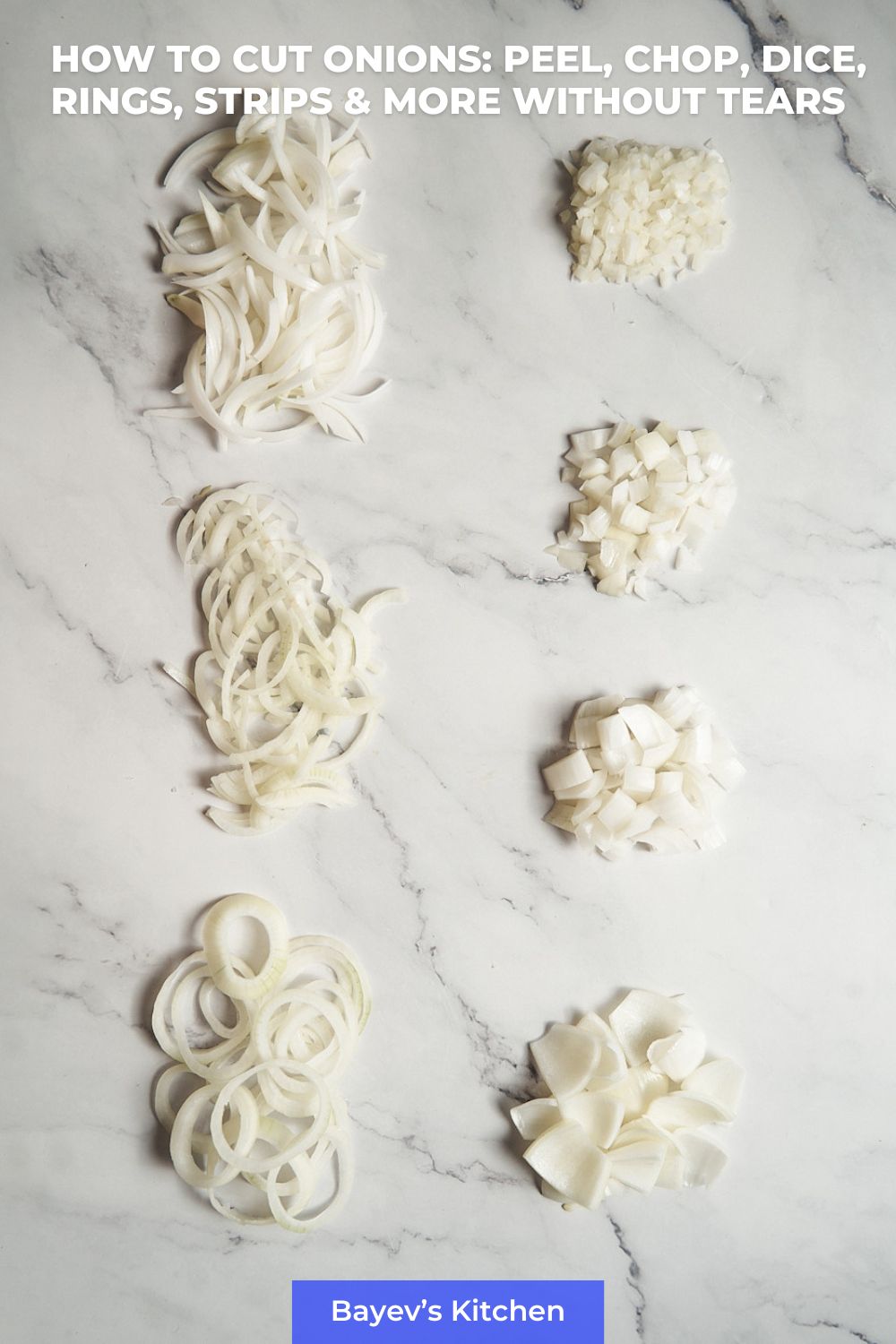Cutting onions is one of the most basic culinary skills.
At some point, I realized that describing the same process in recipes every time was not the most efficient use of time. That’s when I decided to write a general article on this topic, describing all the intricacies and techniques related to cutting onions.
But before we get to the cutting part, I recommend familiarizing yourself with the different types of onions and which ones are suitable for different tasks. Also, learn about the various cutting methods.
Contents
Types of onions, interchangeability, and where they are used
There are 5 main types of onions: yellow, white, red (purple), sweet, and shallots. Theoretically, you could also add leeks and green onions to this list, but we won’t do that here.
Yellow or bulb onion
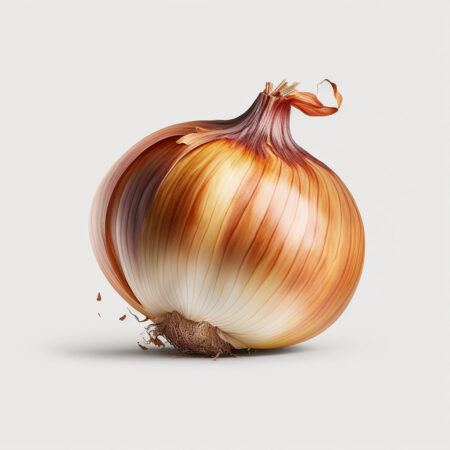
The most commonly used vegetable in the kitchen. It is cheap and readily available. It has an excellent balance of sweetness and spiciness. If a recipe doesn’t specify which type of onion to use, know that it is referring to yellow onions.
Its firmness and high starch content prevent it from turning into mush even during long cooking times.
Uses: It’s best when cooked — fried, stewed, etc. You can eat it raw and add it to salads, but its aroma can be somewhat sharp. And why use it when there are more suitable types of onions?
Substitutes: any other type of onion, except perhaps for purple onions, if we’re talking about long cooking times.
White onion
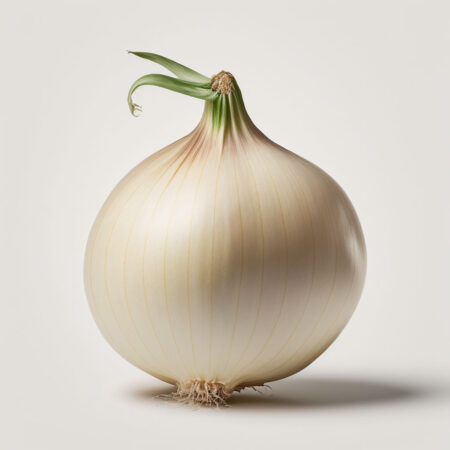
Softer than yellow onions, both in taste and texture. This makes it less suitable for frying, stewing, and baking, but more suitable for consuming raw.
Uses: rarely used in cooking, more often used raw for salads, soups, sauces, and other dishes. Frequently used in Mexican cuisine.
Substitutes: red or sweet onions when raw, and yellow onions for cooking. More ideas – here.
Red (purple) onion
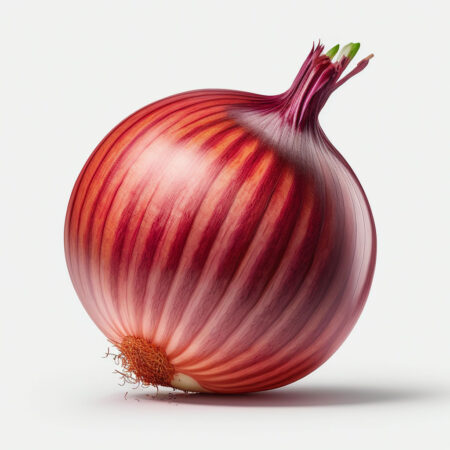
For a long time, I personally considered it sweeter than yellow onions because of the association with sweet Yalta onions, and I attributed its sharp aroma to a poor choice of bulb. But in reality, red onions are spicier and sharper than yellow and white onions.
Rarely used in cooking as it colors surrounding products blue. The same can happen to your cutting board and knife.
So it’s best to wash them immediately after cutting.
It especially colors food during long cooking times—stewing and boiling. Therefore, this type of onion is absolutely unsuitable for making broths.
Uses: raw in salads, grilled or baked in the oven, and other types of quick cooking. Often used in Asian cuisine.
Substitutes: white or sweet onions when raw, and yellow or white onions for cooking. More ideas – here.
Sweet onion
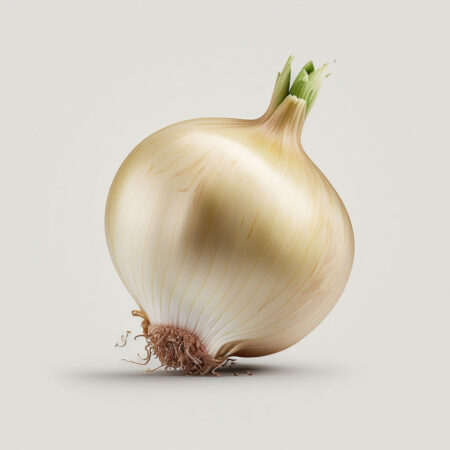
Sweet onion is not so much a separate type but rather a variety of yellow onion (although, for example, Yalta onion, which can be classified as sweet, is not related to yellow onions, but this is more of an exception).
Due to the lower sulfur content in sweet onions, they seem sweeter than yellow onions, with a much less pronounced spiciness. However, they don’t always contain more sugars.
Varieties such as Vidalia, Walla Walla, Cévennes, Bermuda, and Maui have been developed specifically to emphasize sweetness.
In terms of culinary qualities, sweet onions are just as good as yellow onions.
I haven’t seen the sweet onion varieties mentioned above for sale in Ukraine. I rarely see Yalta onions for sale, but if I do, I always buy them.
Uses: raw in salads, burgers, sandwiches, etc.
Substitutes: can be replaced by yellow onions in dishes involving cooking. If a recipe calls for raw sweet onions, it would be more logical to use white or red onions instead of yellow. More substitute ideas – here.
Shallot
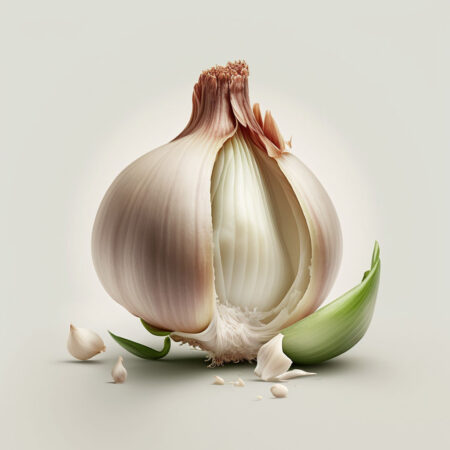
In terms of sweetness, it’s similar to sweet onions, while in terms of spiciness, shallots are somewhere between yellow and white onions. Comparing shallots to other types of onions is not entirely accurate, as they have little in common.
In The Food Lab book, shallots are suggested to be considered more of an onion seasoning rather than an actual onion. They can bring onion flavor to a dish without overpowering it.
Uses: raw in salads, often in sauces to add onion flavor and crispy texture, less frequently cooked.
Substitutes: has a unique taste and texture, so it’s not desirable to replace it with other types of onions. But if necessary, use white or red onions when raw. For cooked dishes, use sweet, yellow, or white onions.
How to peel an onion?
Although peeling an onion is a fairly simple process, it has its own little tricks that significantly simplify subsequent cutting.
I will show 3 ways to peel: for cutting into rings, for cutting in other ways, and for white/red onions.
First, you need to know that the onion has an upper stem part and a lower root part. When cutting into cubes, you don’t need to cut off the lower part. The root will hold the scored parts of the onion together, preventing them from falling apart and making the cutting process much more convenient.
Secondly, in addition to the outer, dry husk, the onion also has another outer layer that needs to be removed. This layer is thin and stiff, similar to paper, and is not needed in finished dishes.
Besides these two outer layers, I sometimes peel the onion by removing the top, edible layer.
Firstly, this speeds up and simplifies the peeling process, especially if you, like me, peel the onion by hand without using a knife.
Secondly, the top layer is often damaged or dried out, so removing it will positively affect the texture and appearance.
The downside of this method is the additional waste. But you can always save it in the freezer (except for the damaged ones) for making vegetable broth instead of throwing it away.
Peeling an onion for cutting into cubes:
- Place the onion on the cutting board sideways and cut off the stem part.
- Cut the onion in half by slicing through the root.
- Peel each half of the onion using your fingers or a small vegetable knife.
Peeling onions for slicing into half-rings and petals
- Place the onion on the cutting board sideways and cut off the stem part.
- Peel each half of the onion using your fingers or a small vegetable knife.
- You can remove as many layers as needed to achieve the desired ring size.
Peeling a whole onion is not as convenient as peeling one that has been cut in half, but there is no alternative in this case.
Peeling white/red onions
- Place the onion on the cutting board sideways and cut off the stem end.
- Cut the onion in half, slicing through the root.
- Peel each half of the onion using your fingers or a small vegetable knife, removing the outer skin and the thin top layer of the onion scales.
Cutting Methods and Flavor
The method of cutting the onion is chosen based on the task at hand. Conventionally, cutting methods can be divided into cubes, half-rings, rings, and petals.
In the shrimp pasta recipe, I mentioned that garlic cut in different ways has a varying impact on the flavor, and the situation is similar with onions. Additionally, the choice of cutting method will also affect the volume of tears you shed.
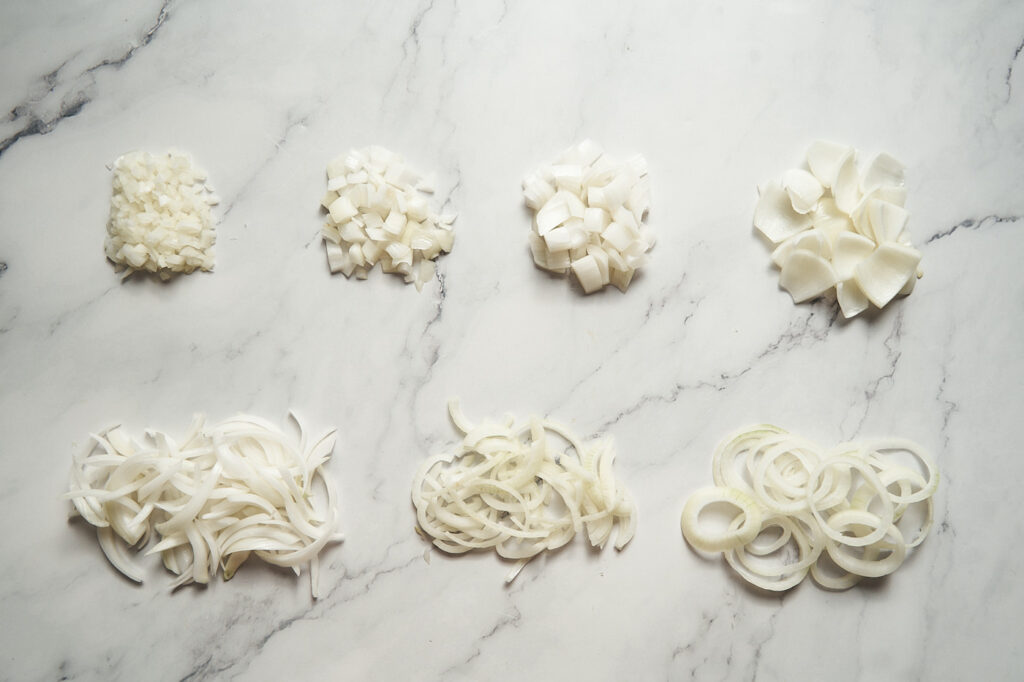
Cutting Methods and Their Applications
Minced onion – used as an addition to sauces and marinades: barbecue sauce, tomato sauce, vinaigrette, and others.
For meat dishes such as meatloaf, hamburger patties, meatballs, and other ground meat dishes, where the texture of the onion should be almost imperceptible.
As a base for soups and stews. For omelets: minced or finely diced onions can be fried before pouring the omelet mixture into the pan, added directly to the mixture, or sprinkled on top of a finished omelet.
Small and medium cubes – used as a base for soups and stews, for adding a zesty crunch to salads, especially good in salads with neutral and flat flavors that need some revitalization – potato salad, cabbage salad, or pasta salad.
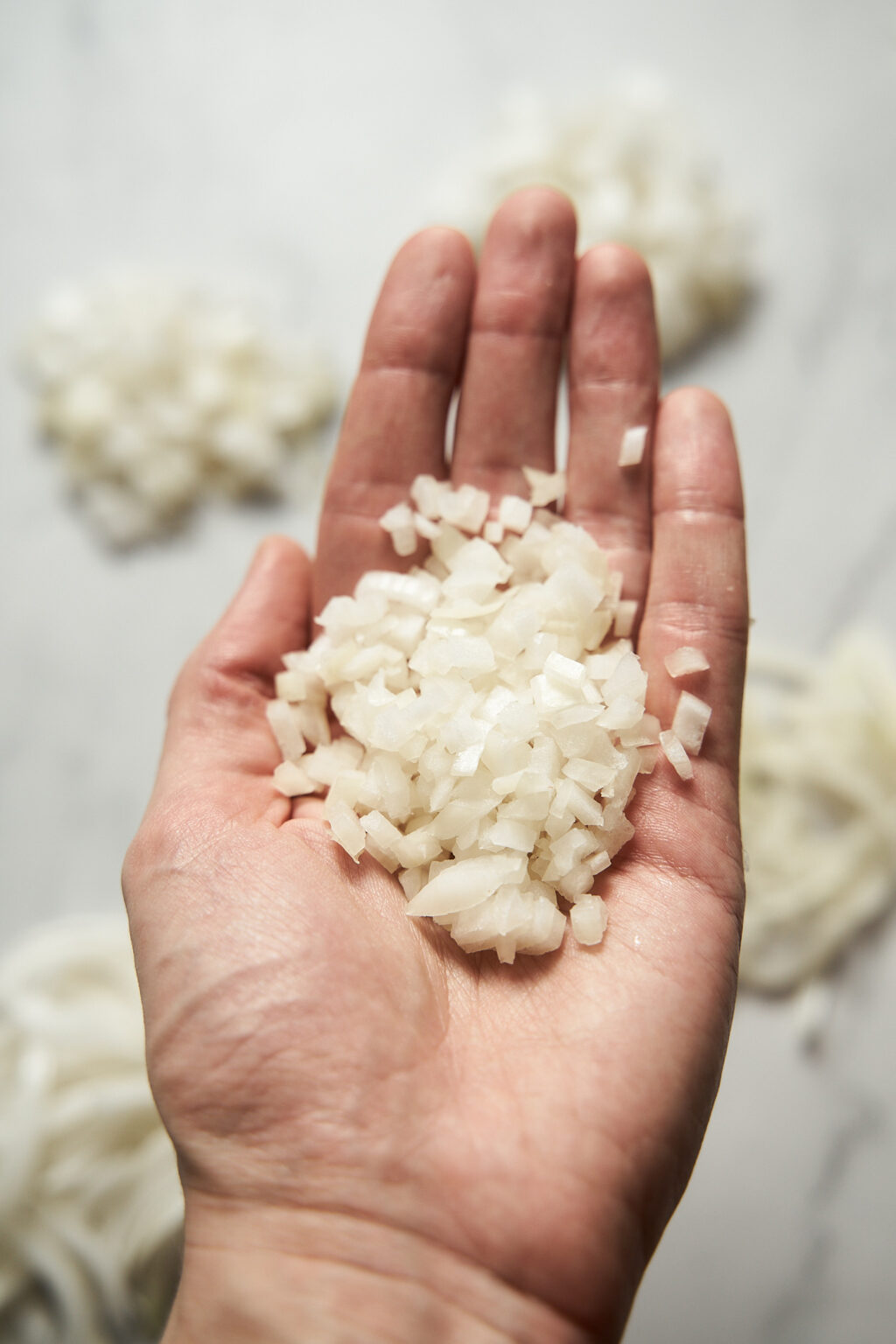
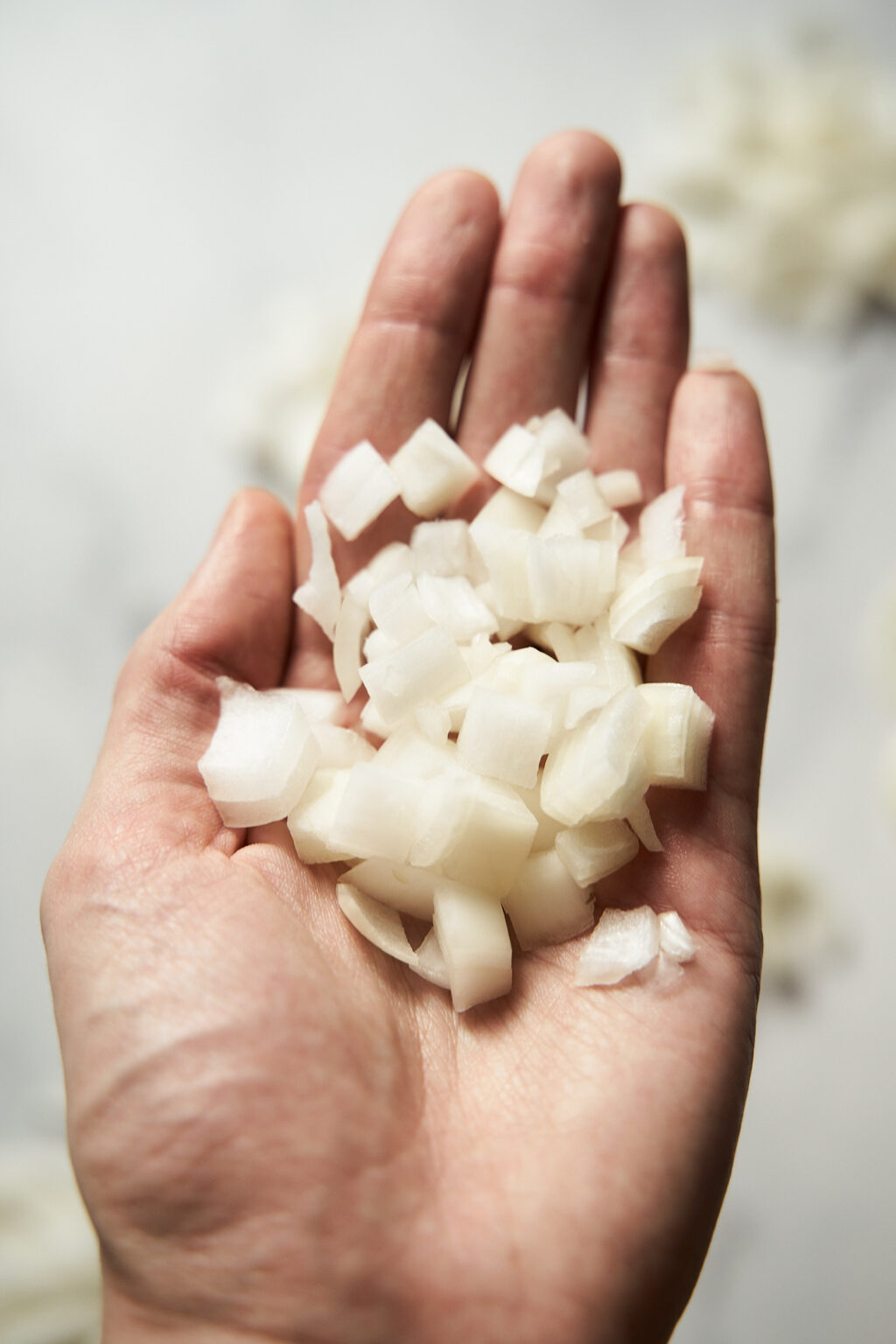
Large cubes – used for stir-fry dishes and sautéing, as well as salads, salsas, and sauces.
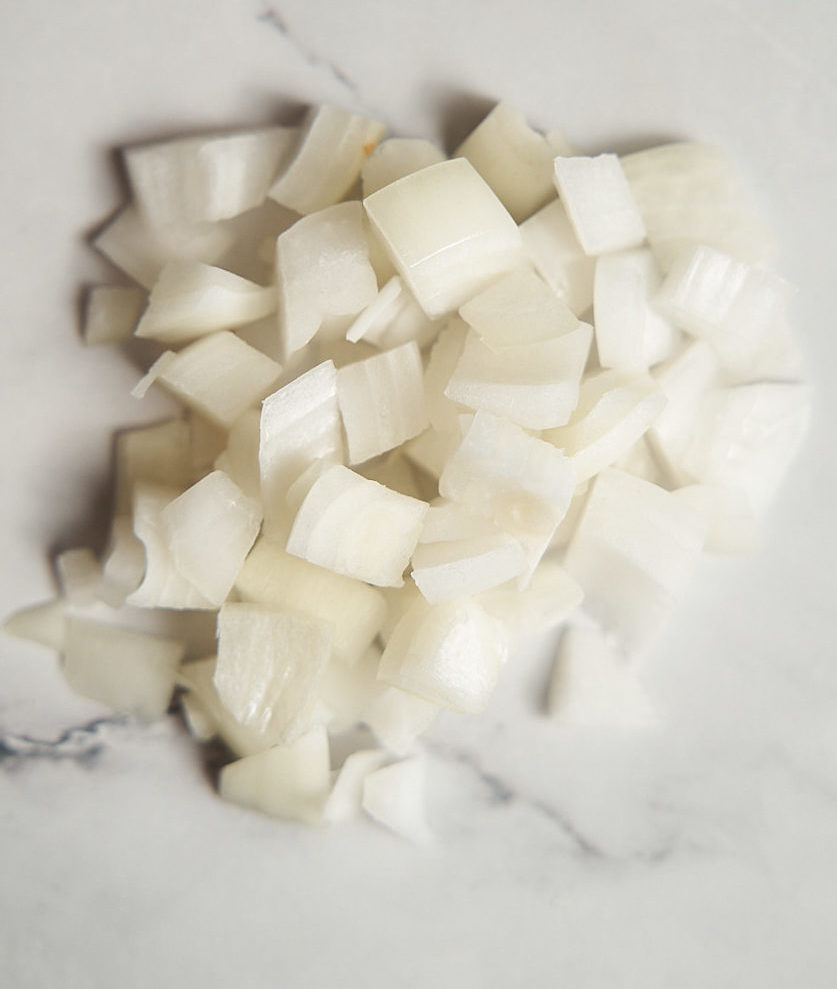

Petals – used for stir-fry and quick sautéing, baking in the oven, and grilling.
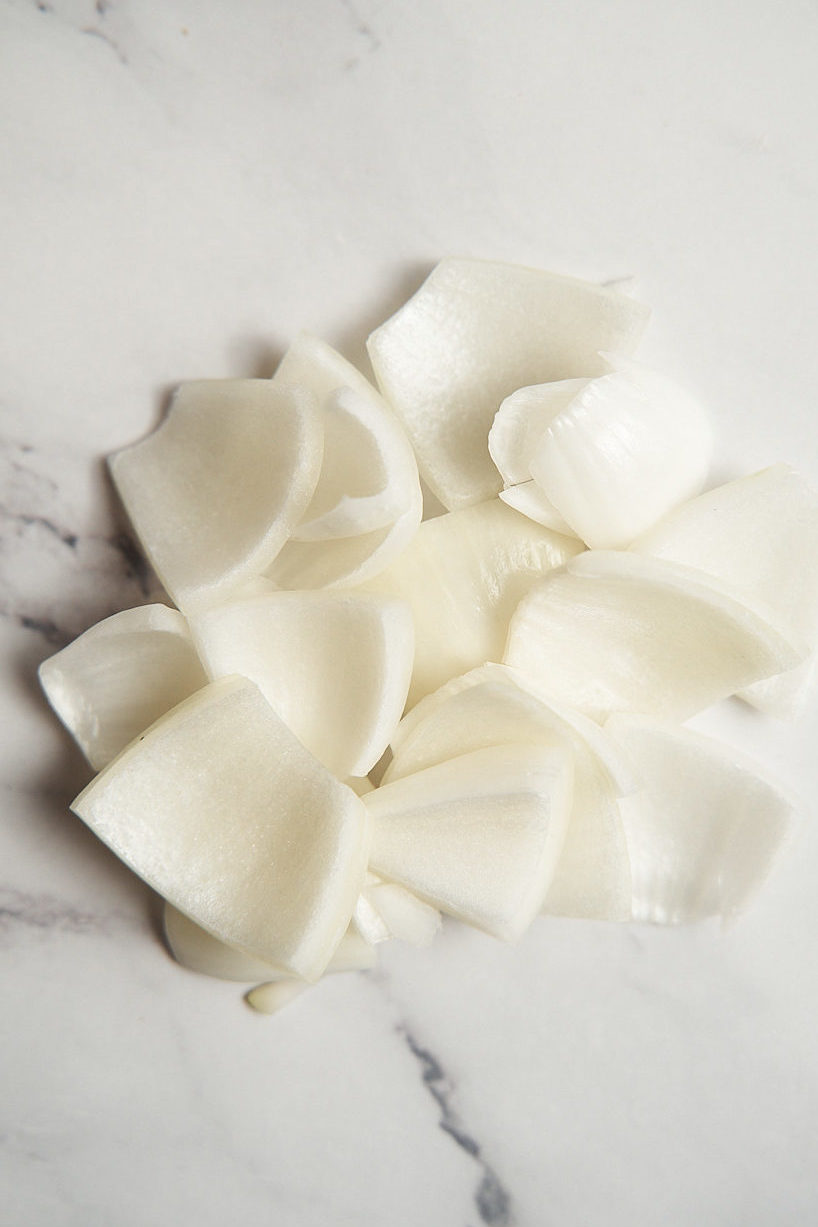
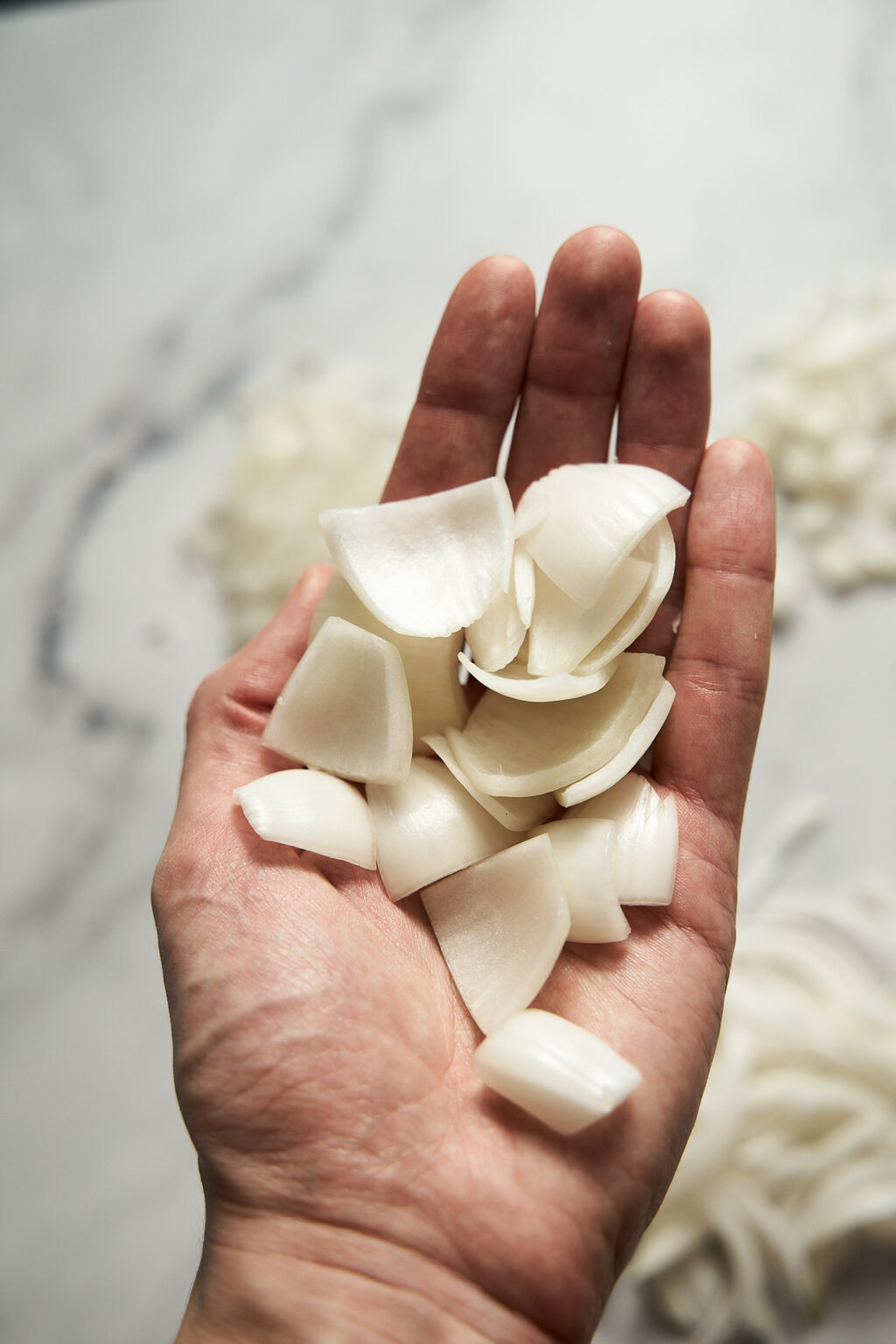
Rings – used for salads, hamburgers, and deep-fried onion rings.
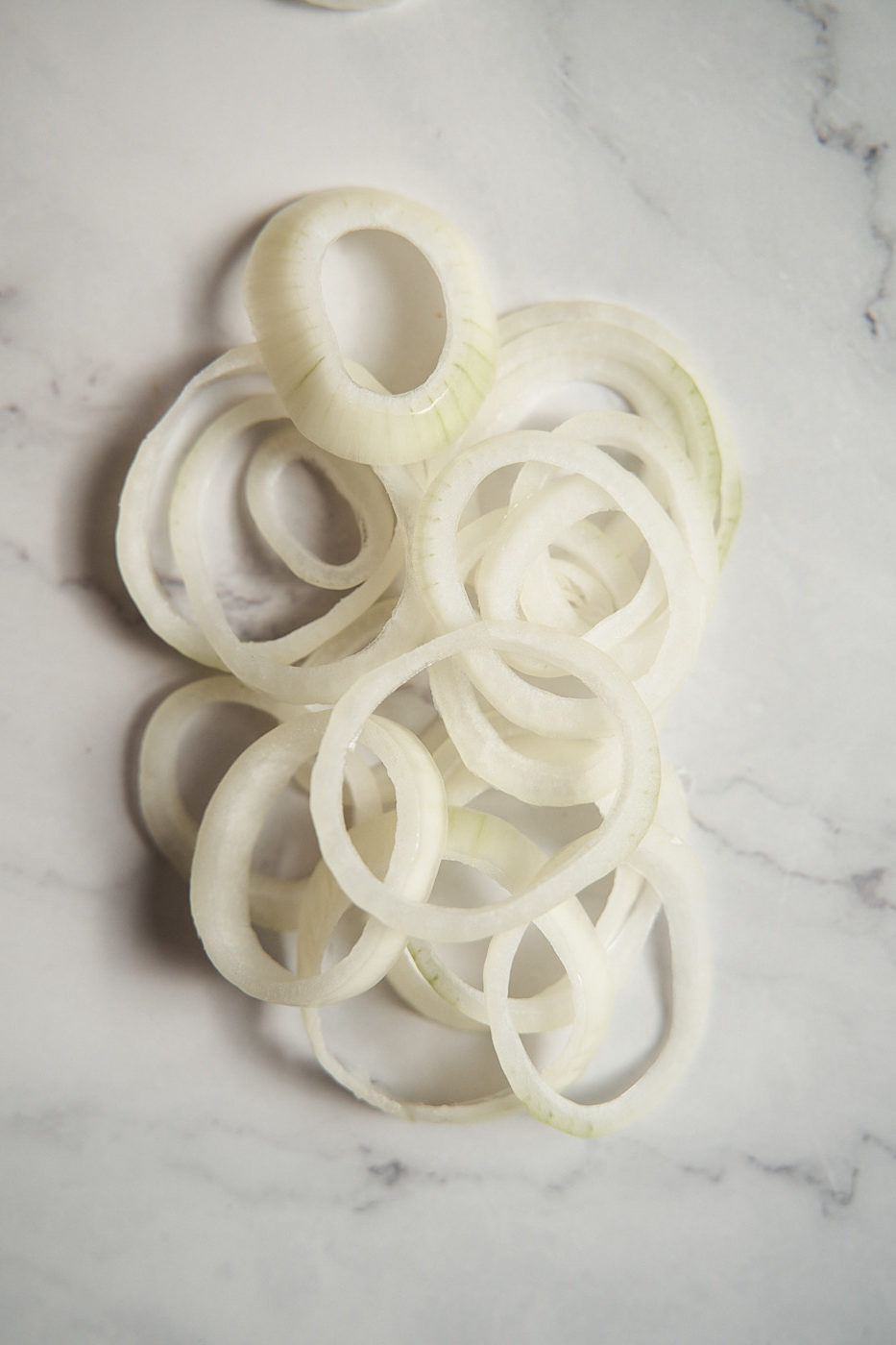
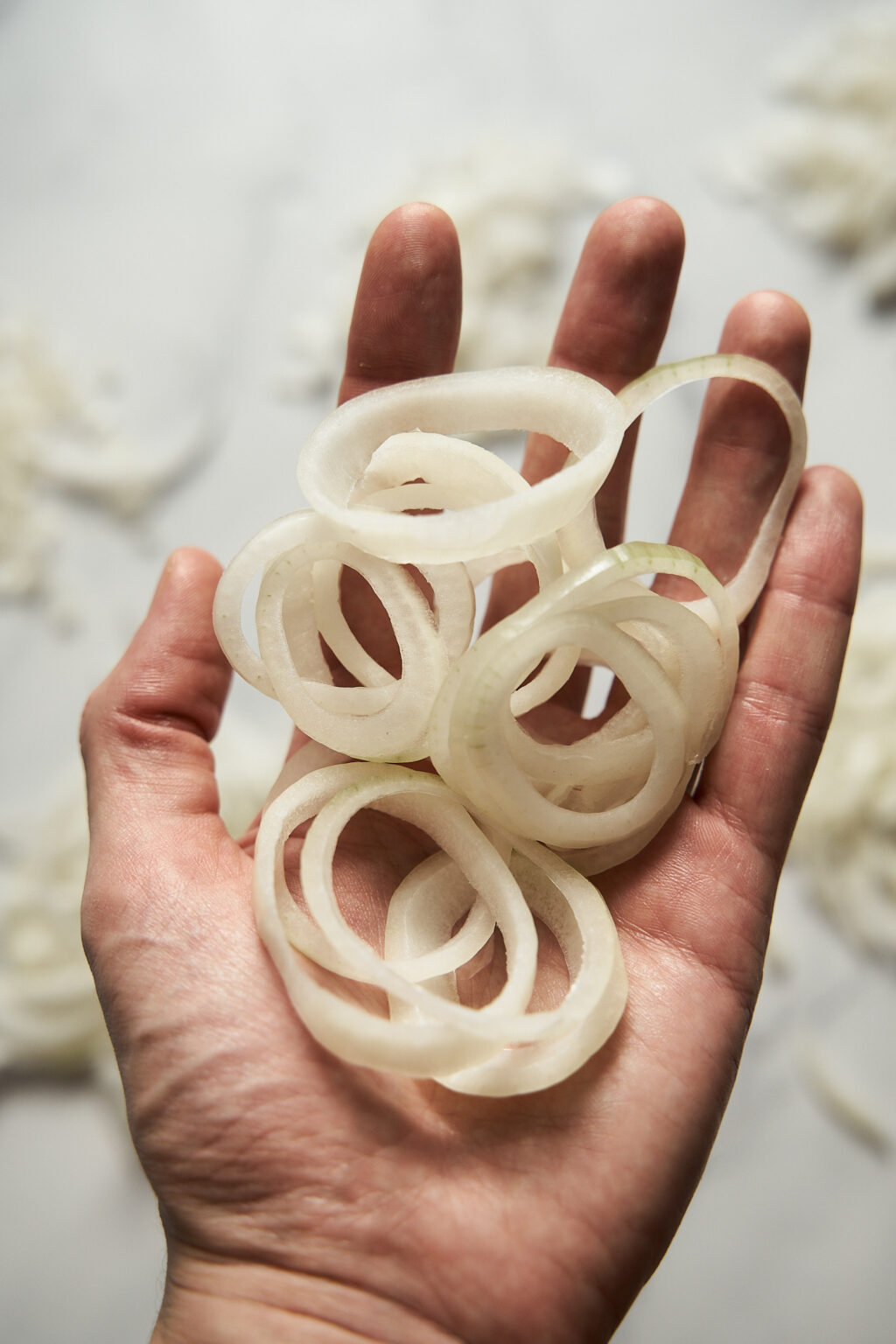
Half-rings/Moon Sliced – used for salads, burgers, sandwiches, and pizza. They add a crunchy texture to the dish.

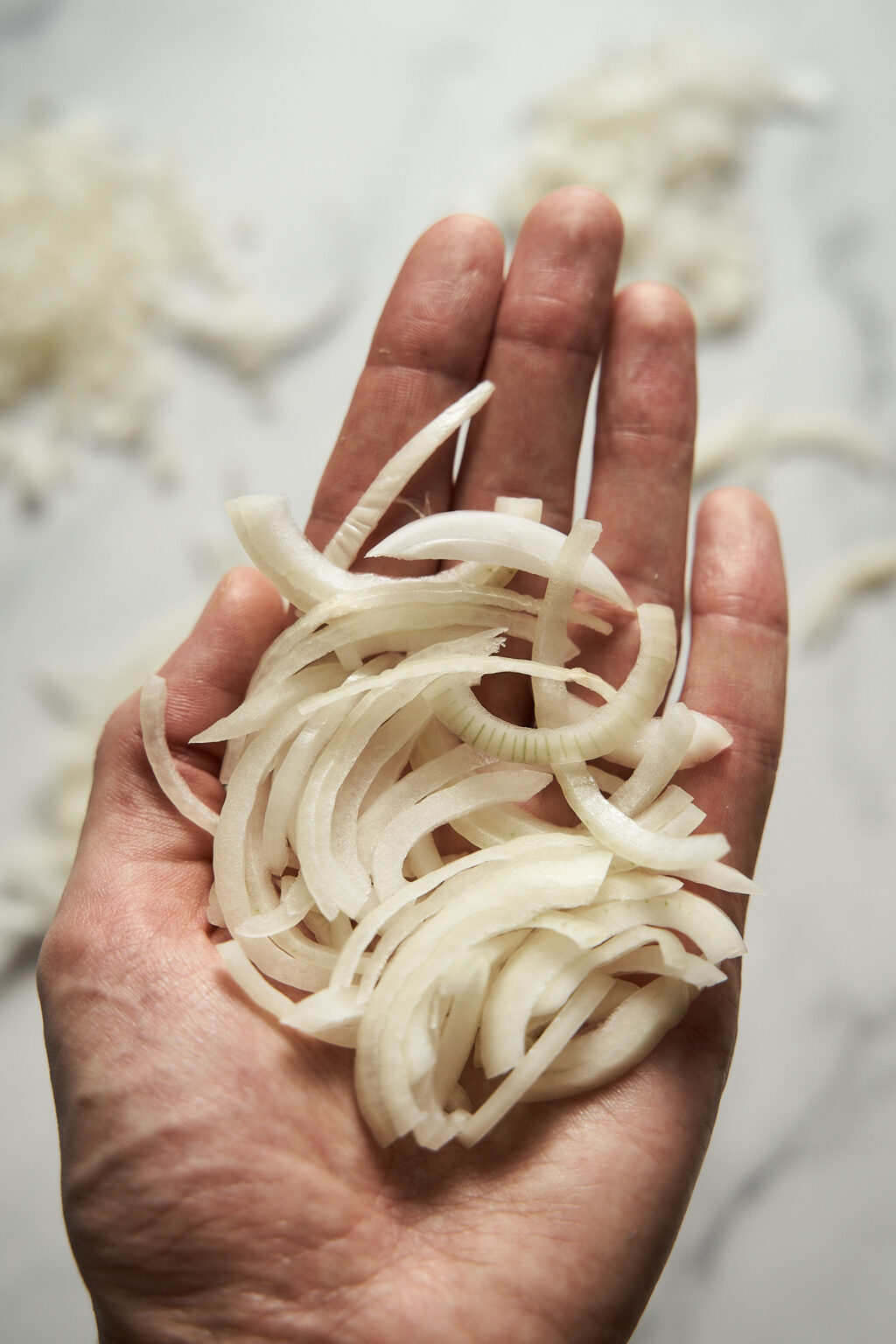
Julienne/vertical slicing – used for stir-fry, sautéing, fajitas, kebabs, caramelized onions, soups, salads, etc.
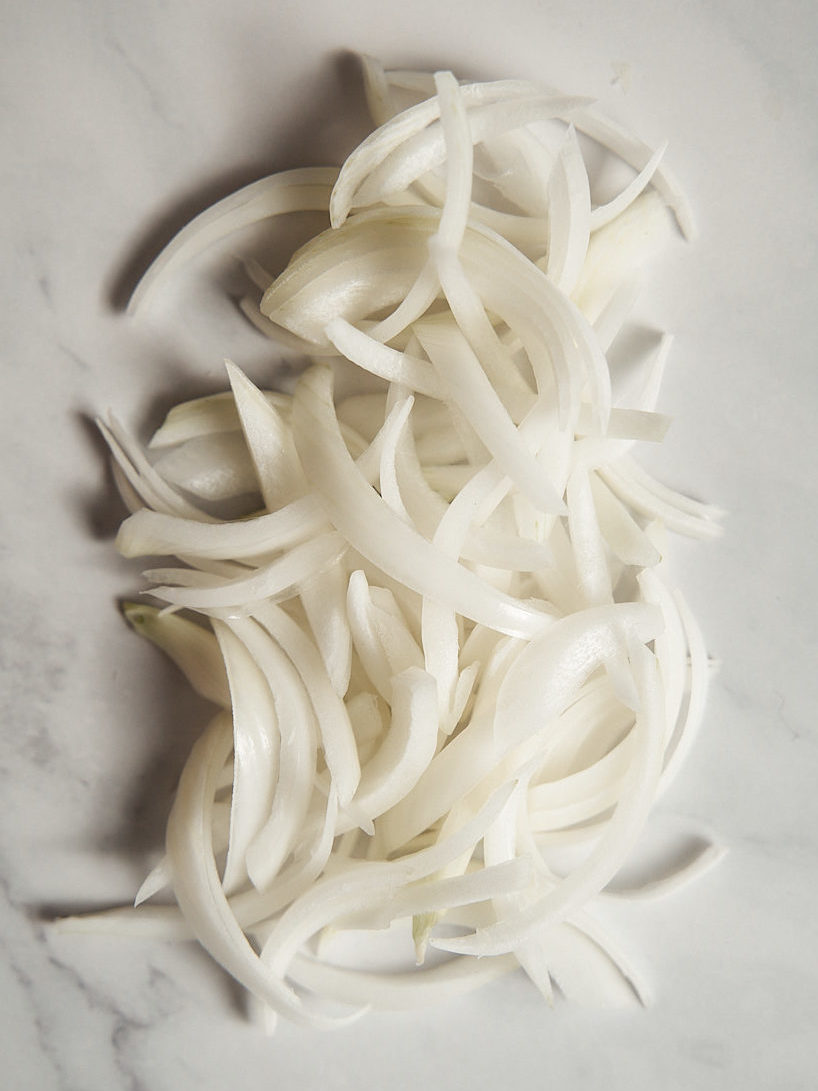

How cutting affects the taste and aroma of onions?
When we cut onions, they release alliinase enzymes, which convert sulfur-containing compounds into sulfenic acids. These acids can then react with other onion molecules, making the aroma sharper and the taste more bitter.
The finer the cut, the faster these enzymes are activated. Moreover, the finer the onion is cut, the more juice is released, which can also affect the taste.
It turns out that the more “knife wounds” we inflict on the onion, the stronger its defensive reaction, making its aroma sharper.
But besides the number of “knife wounds,” their quality is also important. For example, when slicing half-rings, it’s better to use the cutting method from stem to root (also called pole to pole, vertical, or julienne slicing).
In this case, fewer onion cells are damaged because we cut along the fibers, not across. Fewer damages = fewer reactions affecting taste and aroma, and a more pleasant texture.
The sharpness of the knife also affects the taste of the onion. When you cut an onion with a dull knife, it is more like sawing. With each cut, a larger number of onion cells are damaged, resulting in more juice and volatile compounds being released.
What else affects the taste of onions?
However, it’s important to remember that not only cutting affects the bitterness in onions. Other factors are also important: the type of onion, its age, how it is grown or stored.
For example, an onion that has been stored for too long or exposed to light or high temperatures may become bitter or lose some of its taste.
Cooking time can also affect the taste of onions. Finely chopped onions cooked quickly may retain more natural sweetness and have a milder taste, while thicker-sliced onions cooked for a longer time will caramelize and acquire a sweeter and richer taste.
In addition to time, the cooking method is also important. Raw onions are always sharper and crunchier, boiled ones are softer and less aromatic, and fried or sautéed onions are soft, sweet, and rich.
How to remove the sharpness of onions?
Soak the onion in cold water for an hour.
This method will almost completely remove the sharpness and bitterness from white, sweet, and red onions. And it will slightly reduce the sharpness of yellow onions.
How to cut onions?
What do you need for cutting?
As you can guess, any product cutting requires a knife and a cutting board. Is it worth mentioning that the knife should be sharp? For cutting onions (as well as for 70+% of other kitchen tasks), a chef’s knife is most convenient.
To peel the onion bulb, you will need a small vegetable knife, but personally, I prefer to peel the onion with my hands: it is more convenient, faster, and fewer items get dirty.

Dicing and chopping onions
The cubes can be small (about 1/2 x 1/2 cm), medium (1 x 1 cm), and large (1/2 – 2 x 1/2 – 2 cm). The dicing technique differs little depending on the size of the cubes – you simply adjust the number of vertical and horizontal cuts. For finer dicing, make more cuts and vice versa.
Any type of dicing assumes that you have already peeled the onion using one of the methods mentioned above.
Small cubes / dice / finely chopped
- Take a halved onion cut through the root.
- Place the onion with the stem facing you and the root part away from you, and make vertical cuts along the entire length at intervals of 1/2 cm (~1/4 inch), leaving about 1/2 cm (~1/4 inch) untouched near the root.
- Make 1-4 horizontal cuts, depending on the size of the onion and how small you want the cubes to be, holding the knife parallel to the cutting board, also not cutting through to the root about 1/2 cm (1/4 inch).
- Holding the knife vertically, make perpendicular cuts with a step of 1/2 cm (~1/4 inch). Discard the root part or use it in broth.
- If you find a few long, uncut pieces, chop them with a knife.
Minced onion
Method 1: Take finely diced onion and chop it further with a knife to your desired size.
Method 2: Cut onion into large irregular chunks and chop with a food processor.
Medium-sized cubes / dice / chopped
- Take a half of an onion that has been cut through the root.
- Place the onion with the stem facing towards you and the root end away from you. Make vertical cuts every 1cm (~1/2 inch) along the length of the onion, leaving approximately 1/2cm (~1/4 inch) untouched at the root.
- Make 1-3 horizontal cuts with the same spacing, depending on the size of the onion. Keep the knife parallel to the cutting board and do not cut all the way through the root, leaving about 1/2cm (1/4 inch) untouched.
- Holding the knife vertically, make perpendicular cuts with a spacing of 1/2cm (~1/4 inch). Discard the root end or use it in broth.
- If there are any remaining long pieces that have not been cubed, chop them with a knife.
Large cubes/dice
- Take the onion half that has been cut through the root.
- Place the onion with the stem facing towards you and the root end away from you. Make vertical cuts every 1cm (~1/2 inch) along the length of the onion, leaving approximately 1/2cm (~1/4 inch) untouched at the root.
- Do not make any horizontal cuts, or make only one cut for very large onions.
- Holding the knife vertically, make perpendicular cuts with a spacing of 1cm (~1/2 inch). Discard the root end or use it in broth.
Other slicing methods: rings, half rings, and petals
Ring slicing
- Take a peeled onion and place it on the cutting board with the root end facing to the left.
- Make perpendicular cuts through the onion to create rings, adjusting the thickness of the rings based on your needs.
- For stability, you can slice off about 1/2cm from the side of the onion and place it flat on the cutting board.
- When using onion rings, it is recommended to remove the inner membrane to improve their taste and texture.
Onion can be cut into half-moon slices in two ways: from the root to the stem (also known as the pole-to-pole or julienne cut) and by the orbital method (classic half-moon slices).
They differ not only in appearance – the first method will give you a more crunchy and less pungent onion, while the second method will have more onion aroma and bitterness. In addition, it will quickly soften, becoming less appetizing.
Personally, in most cases, I prefer the first method. It not only tastes better but also looks more aesthetically pleasing. It also maintains its shape better during cooking and does not turn into a mush.
Cutting from root to stem / pole-to-pole / julienne cut / strips / vertical cut
- Take a peeled onion and cut off the root end.
- Place the onion with the stem or root end towards you. Holding the knife at a slight angle, almost parallel to the cutting board, cut the onion vertically, adjusting the thickness to your preference.
- As you approach the center, increase the angle of the knife, up to 90 degrees at the center of the onion.
- When you reach the center or slightly beyond, turn the onion on its side for stability.
- Continue cutting in the same manner, adjusting the angle of the knife as at the beginning.
Classic half-rings / horizontal / orbital / half-moon slicing
- Take a peeled half-onion and place it on the cutting board with the root end facing to the left. Do not cut off the root end for easier handling.
- Slice the onion into half-moon shapes of the desired thickness.
Petal slicing
- Take half of a peeled onion and cut off the root end.
- Cut the onion in half lengthwise, then make another cut crosswise, dividing the half onion into four equal pieces.
- Separate the onion layers into individual petals.
How to cut onions even faster?
If you need to cut a large amount of onions, use the assembly line method. Divide the process into small subtasks, such as cutting off the stem and halving the onion, peeling, and slicing.
Complete one task at a time, and only then switch to the next stage.
Onions and tears
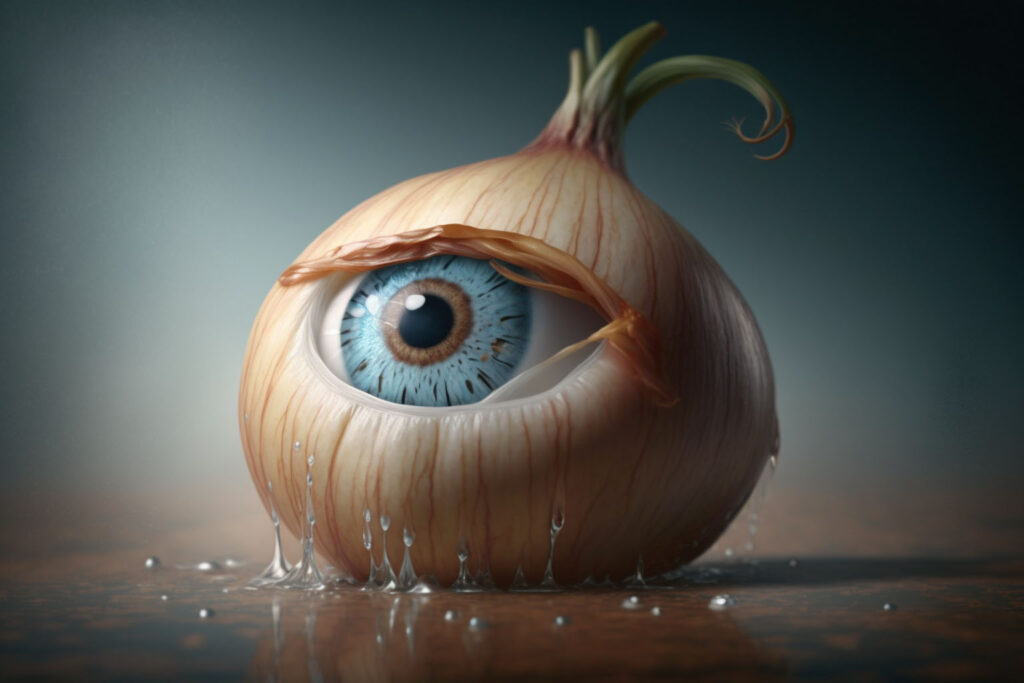
Why do onions make us cry?
When cutting onions, they release a gas called syn-propanethial-S-oxide, which is a lachrymator – a substance that irritates the mucous membranes of the eyes and respiratory tract, causing us to tear up and sneeze.
Interestingly, the gas is only released when we cut the onion. During cutting, sulfur accumulated by the onion from the soil during growth combines with an enzyme stored in the onion cells. When mixed, the enzyme catalyzes a reaction that breaks down sulfur molecules and forms an irritating gas.
When the gas comes into contact with the moisture in our eyes, it forms a weak sulfuric acid, which stimulates the tear glands of the eyes and causes tearing.
This is a natural defense mechanism that the body uses to flush out the irritating substance and protect the eyes from damage.
How not to cry when cutting onions?
Let me say right away that most of the “magical” ways like wetting the knife with cold water, sprinkling salt on the board, chewing gum, filling your mouth with water, and others described on the Internet are complete nonsense.
The same can be said for advice like lighting a candle and placing it next to the cutting board or cutting near a lit stove.
On the one hand, the advice is correct – fire neutralizes the action of the irritating gas. But for this to happen, the onion must be held directly over it, not just nearby.
What really works is soaking the onion in cold water and freezing it for 10-15 minutes before cutting. Cooling the onion slows down the reaction.
The most effective method is eye protection. Goggles with a tight-fitting seal like swimming goggles, ski masks, and contact lenses are suitable.
There are even special protective goggles and masks for cutting onions.
How to store cut and leftover onions
In the refrigerator
Put the sliced onion in an airtight container or wrap it tightly in plastic wrap. Store it in the refrigerator for up to 5 days.
Make sure that no liquid gets into the container or plastic wrap, otherwise, the onion may spoil more quickly.
In the freezer for long-term storage:
If you plan to store the sliced onion for an extended period – freeze it.
Place the sliced onion in a freezer bag, squeeze out excess air, and seal it. You can also use an airtight container or wrap it tightly in plastic wrap.
Frozen sliced onion can be stored in the freezer for up to 8 months.
Freezing does not have the best effect on the texture of the onion, so it is better not to use such an onion for consumption in fresh form. Stick to stewing or use it for making broths.
Marinate the onion
Another great way to preserve leftover onion is to marinate it.
Simple recipe: Place the sliced onion in a jar with a screw-on or tightly fitting lid and pour a mixture of white vinegar and water in a 1:3 ratio. For 250 ml of liquid, add 1 tsp of salt and 1 tbsp of sugar.
Close the lid, shake well, and store in the refrigerator.
Onion Recipes
FAQ
How not to cry when slicing onions?
To avoid tears while cutting onions, try chilling the onion in the refrigerator or freezer for 30 minutes before slicing, or cut it under running water. These methods help to reduce the amount of irritants released by the onion.
What’s the best way to hold an onion while slicing?
Hold the onion with one hand while cutting it with the other. Cut off the onion stem and roots, then cut it in half before slicing. This creates a flat surface that makes it easier to uniformly dice the onion.
How do you evenly dice an onion?
To uniformly dice an onion, first cut it in half from top to bottom. Then, make horizontal cuts across the onion, being careful not to cut through the root end.
Make vertical cuts along the onion and then dice it into small cubes.
Do onions need to be peeled before slicing?
Yes, it is necessary to peel and trim the onion before slicing. This makes it easier to slice the onion into slices or cubes and also removes any possible impurities from the outer layer of the onion.
What’s the best knife to cut onions with?
A sharp chef’s knife or a Santoku knife is ideal for slicing onions. A blunt knife can cause the onion to produce more irritants and result in uneven cuts.
How do you slice an onion into rings?
To slice onions into rings, first cut off the stem and roots of the onion, then peel it. Then slice the onion into rounds of the desired thickness.
How do you shred onions?
To chop the onion, cut it in half from top to bottom, then make horizontal and vertical incisions. Finally, finely chop the onion until it is minced to the desired consistency.
Can I use a food processor to chop onions?
Yes, you can use a food processor to chop onions, but that can lead to uneven chunks and more rips.
How do you store leftover onions after slicing?
To store leftover onions after slicing, wrap them tightly in plastic wrap or put them in an airtight container.
Store it in the refrigerator for up to 3 to 5 days.
What recipes use chopped onions?
Many recipes call for chopped onions, including soups, stews, casseroles, stir-fries and pasta sauces.
What is the best way to store onions to keep them longer?
Store onions in a cool, dry and well-ventilated place, such as a pantry or cellar. Do not store onions near potatoes or other vegetables that release moisture, as this can cause the onions to spoil faster.
What kinds of onions are there and how do you use them in cooking?
There are several types of onions, including yellow, white, red and sweet.
Yellow onions are good for soups and stews, white onions for salsa and guacamole, red onions for salads and sandwiches, and sweet onions for grilling and caramelizing.
How do you know when an onion has gone bad and you can’t eat it anymore?
Bad onions have a soft, mushy texture, a strong smell, and may have mold or black spots on them.
If you notice any of these signs, throw the onion away.
Can I freeze sliced onions for later use?
Yes, you can freeze sliced onions for later use. Simply slice the onions, spread them out on a baking sheet and freeze for 1-2 hours. Then transfer the onions to a freezer bag or container.
What is the difference between sweet and regular onions, and can they be used interchangeably in recipes?
Sweet onions, such as Vidalia, Walla Walla and Maui, have a higher sugar content and lower sulfur content than regular onions, which makes them taste softer and sweeter.
They can be used interchangeably in most recipes, but it can affect the flavor.
How do I properly peel and prepare onions before slicing?
To properly peel and prepare onions, first remove the outer layer, cut off the top and bottom. Cut the onion in half from top to bottom, then remove the skin and any tough or discolored layers.
Rinse the onions under cold water and pat dry with a paper towel.
What precautions should be taken when slicing onions?
When slicing onions, it is best to use a sharp knife to avoid crushing the onion and releasing more tear-inducing compounds.
Wearing protective gloves will also help avoid skin irritation or cuts.
How do you make crispy and flavorful onion rings?
Dip onion slices in seasoned batter or breadcrumbs (such as flour, egg, breadcrumbs), then fry them in hot oil until golden brown.
